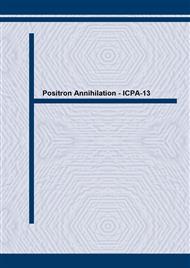[1]
A. K. Bhatia and R. J. Drachman, Phys. Rev. A 42, 5117 (1990).
Google Scholar
[2]
Y. K. Ho, Phys. Rev. A 53, 3165 (1996).
Google Scholar
[3]
A. Igarashi and Shimamura, Phys. Rev. A 56, 4733 (1997).
Google Scholar
[4]
B. H. Bransden, C. J. Noble and R. J. Whitehead, J. Phys. 34, 2267 (2001).
Google Scholar
[5]
Y. K. Ho and Z.-C. Yan, Phys. Rev. A 66, 062705 (2002).
Google Scholar
[6]
M. Kamimura, Phys. Rev. A 38, 621 (1988).
Google Scholar
[7]
Y. K. Ho, Phys. Rep., 99, 1 (1983).
Google Scholar
[8]
Y. Toya, Ph. D. thesis, Tohoku University, Japan, (2003) to be published.
Google Scholar
[9]
E. Brändas and P. Froelich, Phys. Rev. A 16, 2207 (1977). 0.00 0.01 0.02 0.03 0.04 -0.4 -0.3 -0.2 -0.1 E r (au) 0.00 0.01 0.02 0.03 0.04 1 1.2 1.4 1.6 1.8 2 Z 0.0 0.1 0.2 0.3 0.4 0.6 0.8 1 m Ps (au) Figure 4. Electron density at the positron position. (a) Resonant energy dependence of the He 2+ + e – + e + system. (b) Helium nuclear charge dependence and (c) Ps reduced mass dependence of the lowest resonant state. Error bars show the uncertainty mentioned above. Dashed line shows �(mPs =1)mPs 3 which demonstrates the Ps is in the same quantum states as H in HeH 2+. 4 Title of Publication (to be inserted by the publisher)
Google Scholar
[10]
E. Hiyama, Y. Kino and M. Kamimura, Prog. Part. Nucl. Phys. 50, 223 (2003).
Google Scholar
[11]
T. Berggren, Phys. Lett. B 373, 1 (1996).
Google Scholar
[12]
N. Yamanaka, private communications.
Google Scholar


